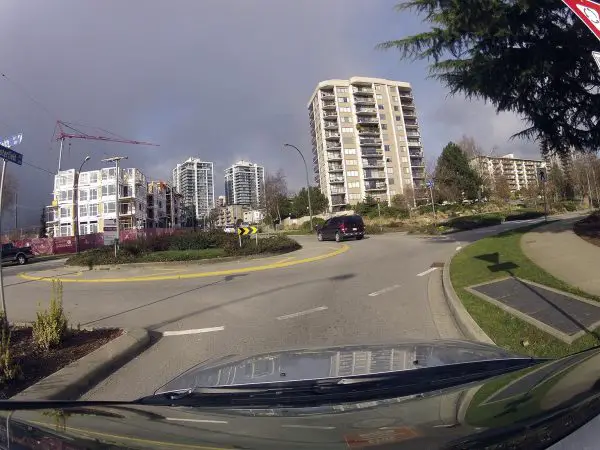Roundabouts and traffic circles are designed to keep traffic moving and improve safety at intersections
Technically, a roundabout is a traffic circle with more than one lane, but these terms seem to be used interchangeably
- On approach, reduce your speed to about 20 km/hr in case you need to yield to other vehicles and for good control
- Look for signs and pedestrians and be prepared.
- You must yield to any traffic already in the roundabout.
- This means you will yield to your immediate left.
- All vehicles must enter to the right and use the roundabout in a counter-clockwise direction.
- You can enter the roundabout when there is a safe gap in the traffic and you feel it is safe.
- Once you are inside the roundabout, vehicles approaching are supposed to yield to you.
- Do not stop inside the roundabout unless traffic conditions require you to do so.
- Keep in mind that if you miss your exit for some reason, it’s possible that you may drive in circles until you find it again.
For continuing straight ahead, do not signal on approach and signal “right” before you leave
For right turns, signal “right” on approach
For left turns, signal “left” (it is a left turn, isn’t it?) on approach and signal “right” before you leave


Residential traffic circles are designed to increase safety and to slow down traffic in residential areas
… Where there may be children, dogs, people walking, bikes, skate boarders, cars backing out of driveways, and other hazards… without necessarily forcing traffic to completely stop as required at 2-way stops and 4-way stops.
- It is generally impossible to have a head-on collision in these intersections
- It is also generally impossible to have a “T-bone” collision, which is one of the worst kinds after the head-on collision
So, how do you navigate the residential traffic circle?
- Slow down as you approach the circle to no more than 20 km/hr, in case you need to yield, and to maintain a reasonable speed in relation to the amount of steering you will be doing
- Scan for traffic and road users like cyclists straight ahead, left, and right
- Yield to any traffic or cyclists already in the circle.
- This means yield to an oncoming left-turning vehicle if it is already in the circle before you; yield to the vehicle on the left if it is has entered the circle before you, and also yield to the right if you arrive at the same time as another vehicle.
- Always go around the circle to the right.
How to Signal in the Traffic Circle
Treat this intersection exactly as you would for any other intersection. It’s very simple:
If you are going straight, do not signal. You’re not turning, you are simply steering around the traffic circle. If you signal right, people think you are turning right; and that could be potentially dangerous if a driver assumes you’re turning and may pull out in front of you.
If you are turning right, signal right before the traffic circle.
If you are turning left, signal left before the traffic circle. This is particularly important in the case where there’s an oncoming vehicle approaching after you’ve already entered the circle. If you have your left signal on, the driver should yield to you and it should be obvious where you are going. If you don’t have a signal, or you signal too late, the driver may assume you’re going straight and might pull in front of you.
Always be prepared in the case where other drivers may not yield. Some drivers are confused at these intersections.
What about emergency vehicles in traffic circles?
Always avoid blocking a traffic circle when there is an emergency vehicle approaching. Stop before entering the circle or exit and then stop to allow the vehicle to pass.
Carmen Cohoe
Carmen became a driving instructor in beautiful North Vancouver at the age of 22 due to some crazy people who agreed to hire her. After that, there was never a dull moment teaching many different folks from many different places how to drive using automatic and standard vehicles and a minivan.


ICBC is right
There is a discussion going on in my hometown about the viability of creating a roundabout on a four lane highway that leads into town to make one particular intersection less dangerous to left turning traffic entering the highway from a stop sign. It has been suggested that ‘slowing traffic through speed reduction signs’ would interfere with the flow of traffic entering and existing the town. What is the correct speed limit within and approaching a roundabout on a highway?